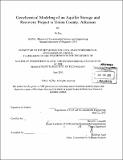Geochemical modeling of an aquifer storage and recovery project in Union County, Arkansas
Author(s)
Zhu, Ni, M. Eng. Massachusetts Institute of Technology
DownloadFull printable version (11.81Mb)
Other Contributors
Massachusetts Institute of Technology. Department of Civil and Environmental Engineering.
Advisor
David E. Langseth.
Terms of use
Metadata
Show full item recordAbstract
The Sparta aquifer in Union County, Arkansas has served as an important potable water supply to the public and industrial sectors in the area. However, increasing water demand and sustained heavy pumping from the aquifer has resulted in the formation of major cones of depression in the area. Union County has been declared as one of the five "critical groundwater areas" in Arkansas due to rapid water level declines, salt water intrusion and overall withdrawals exceeding the rate of natural recharge. To mitigate the adverse impacts of a depleted aquifer, Aquifer Storage and Recovery (ASR) by well injection at the center of the cone of depression is evaluated to address the issue. ASR is the injection of potable water into an aquifer for storage and recovery for use when needed. One important aspect in successful design and operation of ASR systems is to assess the potential geochemical reactions between the injected water and the local aquifer water, which are typically of very distinctive compositions and environmental conditions. The goal of this paper is to use the geochemical modeling software PHREEQC to simulate the scenario of injecting partially treated surface water from Ouachita River into the Sparta aquifer at the city of El Dorado. Key reactions modeled include the initial mixing of the two waters in the proximal zone, surface exchange reactions of the major cations, iron precipitation/ dissolution reactions and the oxidizing potential of the injection water. Results from the modeling indicate that reducing the oxygen content of the injection water to enhance geochemical compatibility with the anoxic aquifer water would be beneficial. Arsenic dissolution or attenuation could occur depending on the mixing ratio of injection water to groundwater. Oxidation of ferrous ions is modeled to illustrate the oxidizing potential of the mixed water in the aquifer and the potential of iron precipitation is assessed.
Description
Thesis (M. Eng.)--Massachusetts Institute of Technology, Department of Civil and Environmental Engineering, 2013. Cataloged from PDF version of thesis. Includes bibliographical references (pages 70-76).
Date issued
2013Department
Massachusetts Institute of Technology. Department of Civil and Environmental EngineeringPublisher
Massachusetts Institute of Technology
Keywords
Civil and Environmental Engineering.